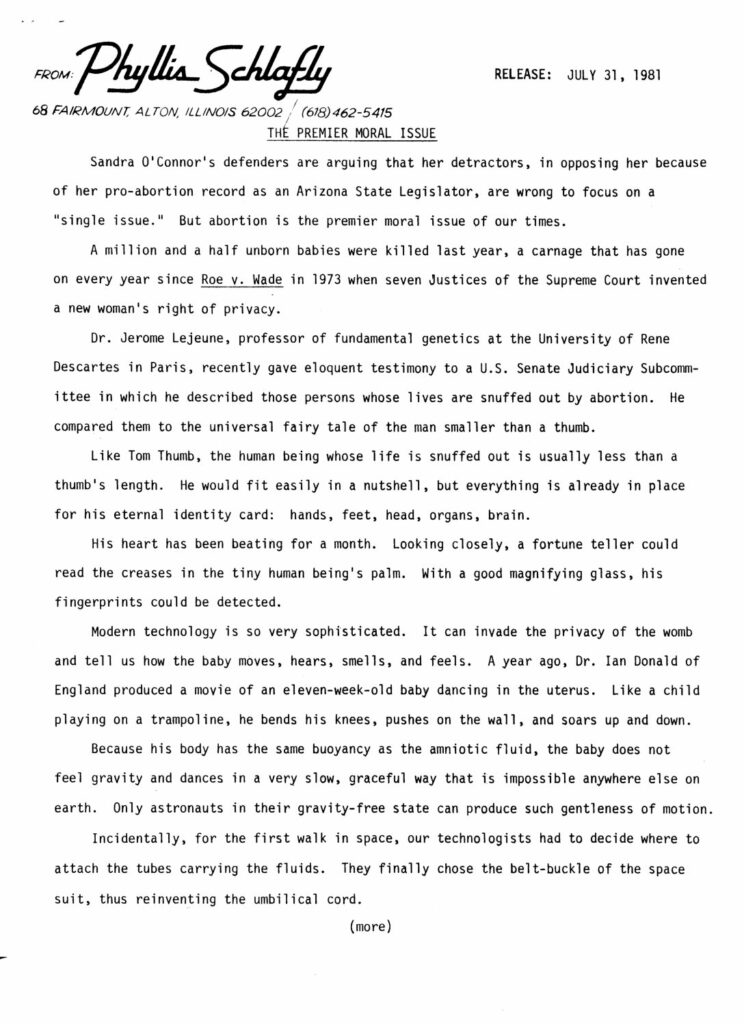
THE PREMIER MORAL ISSUE
Sandra O’Connor’s defenders are arguing that her detractors, in opposing her because of her pro-abortion record as an Arizona State Legislator, are wrong to focus on a “single issue.” But abortion is the premier moral issue of our times.
A million and a half unborn babies were killed last year, a carnage that has gone on every year since Roe v. Wade in 1973 when seven Justices of the Supreme Court invented a new woman’s right of privacy.
Dr. Jerome Lejeune, professor of fundamental genetics at the University of Rene Descartes in Paris, recently gave eloquent testimony to a U.S. Senate Judiciary Subcommittee in which he described those persons whose lives are snuffed out by abortion. He compared them to the universal fairy tale of the man smaller than a thumb.
Like Tom Thumb, the human being whose life is snuffed out is usually less than a thumb’s length. He would fit easily in a nutshell, but everything is already in place for his eternal identity card: hands, feet, head, organs, brain.
His heart has been beating for a month. Looking closely, a fortune teller could read the creases in the tiny human being’s palm. With a good magnifying glass, his fingerprints could be detected.
Modern technology is so very sophisticated. It can invade the privacy of the womb and tell us how the baby moves, hears, smells, and feels. A year ago, Dr. Ian Donald of England produced a movie of an eleven-week-old baby dancing in the uterus. Like a child playing on a trampoline, he bends his knees, pushes on the wall, and soars up and down.
Because his body has the same buoyancy as the amniotic fluid, the baby does not feel gravity and dances in a very slow, graceful way that is impossible anywhere else on earth. Only astronauts in their gravity-free state can produce such gentleness of motion.
Incidentally, for the first walk in space, our technologists had to decide where to attach the tubes carrying the fluids. They finally chose the belt-buckle of the space suit, thus reinventing the umbilical cord.
The preborn baby is just as viable in his life-capsule, the amniotic bag, as an astronaut on the moon in his space-suit. Refueling with vital fluids from the mother ship is essential, just as nurturing of the baby is indispensable for survival. But that does not make the baby part of the mother’s body any more than it makes the astronaut part of his sophisticated spaceship.
Scientists have agreed for years that test-tube babies, if produced, would demonstrate the autonomy of the fertilized ovum. This is why the two British doctors, Robert Edwards and Patrick Steptoe, could witness in vitro (in a test tube) the fertilization of Mrs. Brown’s ovum from Mr. Brown’s sperm. The tiny ovum which the doctors implanted days later in Mrs. Brown’s womb could not be part of her own body, or a tumor or an animal. It was the incredibly young Louise Brown, who has now grown to be three years old.
After a cow’s ovum has been fertilized by a bull’s sperm, the tiny two-milligram substance is often transported across the ocean and implanted inside the uterus of a recipient cow. The best shipping equipment is a rabbit’s fallopian tube. Months later, the newborn calf exhibits all the genetic endowment it received from its true parents and none of the qualities of the rabbit or of its uterine foster mother.
Modern genetics teaches that, as soon as the 23 chromosomes from the father are united, through fertilization, to the 23 maternal chromosomes, the new individual immediately has all his inborn qualities. This substance is so minute that it can fit neatly on the point of a needle, but it contains all the genetic information and material sufficient to build our body and even our marvelous brain.
Even more impressive is the fact that each fertilized ovum is an entirely original combination that has never occurred before and will never occur again. Each incredibly tiny baby is unique and irreplaceable.
After fertilization has taken place, a new human being has come into existence. This is not a matter of faith or religion or opinion. It is scientific fact based on clear and massive experimental evidence.
When Ronald Reagan was elected President, the pro-abortion majority on the Supreme Court was 7 to 2. He has the power to reduce that unconscionable majority with each new appointment. The people who elected him have a right to expect him to do that.






